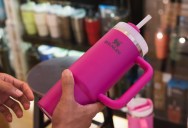Customers Are Filing Lawsuits Accusing Stanley Cups Because They Contain Lead
by Trisha Leigh

You’d have to be blind not to be able to recognize a Stanley cup on site right now – they’re literally just about everywhere you look, in every color under the sun.
But do they contain lead? Three lawsuits say yes and there are videos on Tiktok to prove it…
@leadsafemama_2022 #StanleyCup #StanleyQuencher #LeadPoisoning #LeadPoisoningPrevention #LeadSafeMama #LeadCheckTestKit
The lawsuits are filed against Pacific Market International (PMI), who has owned Stanley since 2002. They claim the popular Stanley Quencher Tumblers contain a toxic level of lead.
For their part, Stanley admits the mugs contain lead but state that users would only be exposed if the cups were damaged.
The lawsuits, all brought by women, allege the brand misled them by failing to disclose the contents.
“PMI’s primary target market is young professional women of childbearing age. PMI spends enormous sums to reach this market by paying influencers to advertise Stanley cups as safe, durable products.”
Some of the influencers who helped Stanley reach their new demographic of buyers are encouraging their followers to throw their Stanley cups in the trash.
Another suit takes issue with the fact that PMI attempted to reassure their customers by telling them only damaged cups could leak lead.
“This is likely to mislead reasonable consumers, as it does not warn consumers about the potential for damage to the vacuum seal and does not disclose how much lead is present in each tumbler cup.”

Many consumer products contain lead, and we’re assured by the powers that be that we’re safe from the toxicity levels.
That said, we’re all left wondering just how much damage does a Stanley cup have to sustain before it starts leaking lead?
And how much is in there?
I hope we get some definitive answers, soon.
If you think that’s impressive, check out this story about a “goldmine” of lithium that was found in the U.S. that could completely change the EV battery game.
Categories: Internet News, SCI/TECH, STORIES
Tags: · business, customers, danger, law, lead, legal, safety, science, single topic, stanley cups, top

Sign up to get our BEST stories of the week straight to your inbox.




